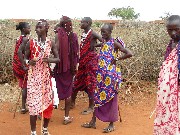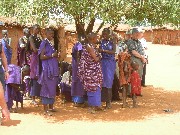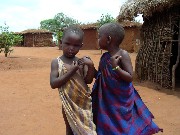


Before we coming to Tsavo Est, we visited a Masai village that was open to tourists. Well, I must say that Masai live today in the same way as they lived hundreds of years ago. The houses made from wood and mud, very little and very dark, but the temperature inside is very supportable. Masai are a beautiful people, tall and thin. He likes jewelry a lot, and males get a big hole in their ears: the bigger the hole, the man is more important. Despite a very uniform nutrition, a lot of meat and milk (vegetables are not eaten because they belong to the land that belongs to God), they are a very healthy people and know only few diseases. Perhaps we should learn something from them about the eating: natural food, but in a very different way from what doctors and especially the media often advise us.
The safari started when we arrived to Tsavo Est. This national park is characteristic for the red color of the soil that gives a special impression, together with reach vegetation. Numerous sorts of animals are present in the site, and we were very fortunate because we saw a lion too; it's not an animal that can be seen in each safari, due to a vast area that the park occupies.
In the two photographs with the lion, shown above, on the left, there is an interesting thing to say. We all know that the male lion has a thick mane, while lionesses lack this. Females need to be attracted to males, so they can do less with regards to jewelry and various beauty gadgets. It seems that a lioness posed for the photo, but in this case it is not true. This is a Tsavo lion. Their characteristic is a very little expressive mane and many tourists mistake them for females. I had asked our guide why this anomaly. He replied, with a joke, that their lions are already beautiful in themselves and that they don't need any further embellishment.
As this was our first safari, and I hope it will not the last, our heart beat fast, and the adrenaline spread through the body. Wherever you look, the animals were all around. In their natural ambience, on the beach or on a rest in the shade of a tree or in the interplay of games - beautifully. I had a big problem because I did not know what to do. On the one hand, I wanted to perpetuate myself with my digital camera that I specifically bought for that 10-by-10 zoom opportunity (professionals say it's minimum for a photo safari). On the other hand, constant clicking takes away the attention of the object of this journey and does not allow you to fully enjoy the flora and fauna.
Crocodile Camp, where we stayed, took its name for the presence of crocodiles at the border of the camp, on the little beach of the near river. For the tourists of the camp, a special spectacle each evenings is feeding the crocodiles with the pieces of fish. After two days that we spent in Tsavo Est, 8th February we left this beautiful place, and in the morning reached, with a little plane, Lake Nakuru, another paradise in this amazing country, called Kenya.
Kenya Safari | Tsavo Est Lake Nakuru Masai Mara Kimana Watamu Videos Link